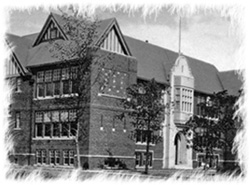Learn more about King Edward Public School!
Address and Location
King Edward Public School
853 Chilver Road
Windsor ON
N8Y 2K5
Contact us
Phone: (519) 256-4999
Fax: (519) 256-0677
Accessibility
We are committed to providing an accessible environment for students, staff, families and our community. Learn how you can notify us about an accessibility concern for your child, view our Multi-year Accessibility Plan and find out more about our school's accessible infrastructure.
King Edward Public School's Proud History
When you look at King Edward School today, complete with neighbouring majestic homes and local parks, it's hard to imagine that the school was originally built in an open field with very little surrounding it. In 1906, the year King Edward School officially opened, the neighbourhood looked dramatically different than it does today.
In the late 1800s, the town of Walkerville was growing around the distillery that Hiram Walker founded in 1858. The town's first educational institution, Walkerville Public School, was located on Wyandotte Street, the former site of the Walter D. Kelly Funeral Home. This eight-room structure served to educate Walkerville's children from 1880 to 1905. The school population boomed to nearly 300 in 1904 and prompted the need for a much larger building. That same year, the local school board purchased the block of land where King Edward now sits and requested the services of renowned architect, Albert Khan, to design a "modern" building that could accommodate 14 classrooms and several administrative offices. Kahn was already familiar with the Walkerville neighbourhood, having designed Willistead Manor.

Construction of the new building commenced in April 1905 and carried on into the next year at a cost of $50,000. Although the sum seems trivial by today's standards, keep in mind that in 1906 a loaf of bread cost only four cents and the average wage for a production worker was $375 per year! The structure was completed in March 1906 and Hugh Beaton, whose name you will recognize on another school in Windsor, became the first principal. After a three-day holiday to move furniture to the new site, King Edward's doors were opened for instruction on the 28th of March. Rather than carry over the "Walkerville Public" moniker, the school adopted the name of the sovereign king at the time. On the eve of April 11th, 1906, King Edward School was officially opened.
At this time in Walkerville's history, very few buildings stood on Chilver (known back then as Victoria St.) and Windermere streets. Willistead Manor was a recent addition to the neighbourhood and Chalmers United Church, to the west of King Edward School, was not built until 1908. Essentially, the school was all by its lonesome in an open oat field. Students spent many a year trudging through the mud to get to school. Over the decades, as the neighbourhood matured around the school, very few structural changes were made to the original building. Hugh Beaton served as principal until 1917. Succeeding him was Oliver Stonehouse whose 28-year run as principal makes him King Edward's longest serving administrator.
In the 1930s, when most of the economic world wallowed in the Great Depression, King Edward and the Walkerville area were experiencing a different kind of growth. In 1935, Walkerville, Sandwich and East Windsor amalgamated into the City of Windsor. Two years later, the school's population reached its highest peak ever at 600 students. If you do the math - remember, only 14 classrooms - you can only imagine how big the class sizes must have been. In 1938, the Home & School Association came into being and, through the decades, has continued to support the learning environment.
By the 1950s, the Home Economics & Manual Training program was relocated to King George School and Walkerville Collegiate. In 1956, the King Edward School community enjoyed its golden anniversary and, twenty-five years later, celebrated 75 years of existence. Staff and students came and went over the second half of the century as the neighbourhood matured around it.
As time and age took its toll on the building, the fate of the school was decided in the early 1990's. Arguments to preserve the structure and its heritage fell short against those in favour of an entirely new building. From 1993-1995, King Edward students were bussed to the then vacant Edith Cavell School in Riverside while the old King Edward faced the wrecking ball. Under the guidance of J.P. Thomson & Associates, the new building rose from the ground, fully equipped with modern amenities. A time capsule, filled with items gathered by the grade seven and eight students, was put together and sealed in the building in December 1994. Although the new building bears a resemblance to Khan's masterpiece from 1906, the stone facade, saved from demolition, is all that remains of the original King Edward structure. The original school bell, first used in the eight-room schoolhouse at Walkerville Public in 1886, hangs high in the foyer of the new building.
Allergies and Foods/Scents Restrictions
We are committed to maintaining a safe environment for all students and staff. Learn about our allergy alerts, including restrictions on sending certain types of foods and scents with your child to school.
King Edward must restrict Shellfish and Scents and Fragrances within our building due to allergies.
Bullying Prevention and Intervention
The GECDSB's Bullying Prevention and Intervention Plan outlines our long-term, school-wide approach regarding bullying prevention and intervention, including:
- Education, awareness and outreach
- Bullying and cyber-bullying
- Types of behaviour and evaluation of evidence
- Policies and procedures
- Approved strategies and programs
- Goals and action plans
Code of Conduct
The GECDSB's Safe Schools Policy is based on the provincial Education Act and the Ontario Code of Conduct, which set clear standards of behaviour for students, staff, parents, guardians, volunteers and any other individuals involved in public education.
View our Code of Conduct policies, including standards of behaviour and employee standards of conduct.

